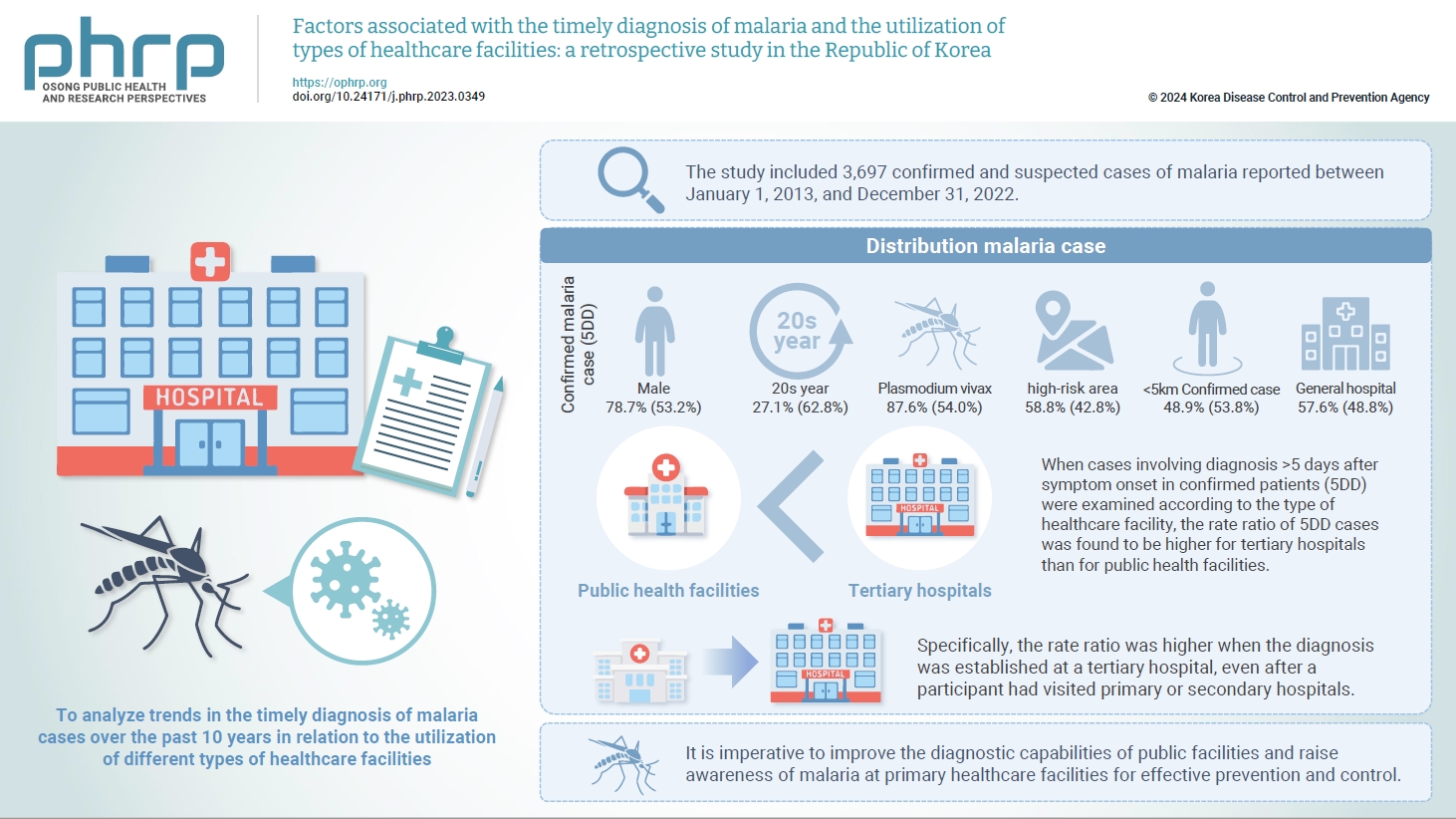Search
- Page Path
- HOME > Search
Original Article
- Factors associated with the timely diagnosis of malaria and the utilization of types of healthcare facilities: a retrospective study in the Republic of Korea
- HyunJung Kim, Sangwoo Tak, So-dam Lee, Seongwoo Park, Kyungwon Hwang
- Osong Public Health Res Perspect. 2024;15(2):159-167. Published online April 16, 2024
- DOI: https://doi.org/10.24171/j.phrp.2023.0349
- 565 View
- 22 Download
-
 Graphical Abstract
Graphical Abstract
 Abstract
Abstract
 PDF
PDF 
- Objectives
This study aimed to analyze trends in the timely diagnosis of malaria cases over the past 10 years in relation to the utilization of different types of healthcare facilities. Methods: The study included 3,697 confirmed and suspected cases of malaria reported between January 1, 2013, and December 31, 2022, in the national integrative disease and healthcare management system. Some cases lacking a case report or with information missing from the case report were excluded from the analysis. A generalized linear model with a Poisson distribution was constructed to estimate risk ratios and 95% confidence intervals adjusted for other variables, such as distance. Results: When cases involving diagnosis >5 days after symptom onset in confirmed patients (5DD) were examined according to the type of healthcare facility, the risk ratio of 5DD cases was found to be higher for tertiary hospitals than for public health facilities. Specifically, the risk ratio was higher when the diagnosis was established at a tertiary hospital, even after a participant had visited primary or secondary hospitals. In an analysis adjusted for the distance to each participant’s healthcare facility, the results did not differ substantially from the results of the crude analysis. Conclusion: It is imperative to improve the diagnostic capabilities of public facilities and raise awareness of malaria at primary healthcare facilities for effective prevention and control.
Article
- Improving Service Quality in Long-term Care Hospitals: National Evaluation on Long-term Care Hospitals and Employees Perception of Quality Dimensions
- Jinkyung Kim, Woosok Han
- Osong Public Health Res Perspect. 2012;3(2):94-99. Published online June 30, 2012
- DOI: https://doi.org/10.1016/j.phrp.2012.04.005
- 2,815 View
- 16 Download
- 10 Crossref
-
 Abstract
Abstract
 PDF
PDF - Objectives
To investigate predictors for specific dimensions of service quality perceived by hospital employees in long-term care hospitals.
Methods
Data collected from a survey of 298 hospital employees in 18 long-term care hospitals were analysed. Multivariate ordinary least squares regression analysis with hospital fixed effects was used to determine the predictors of service quality using respondents’ and organizational characteristics.
Results
The most significant predictors of employee-perceived service quality were job satisfaction and degree of consent on national evaluation criteria. National evaluation results on long-term care hospitals and work environment also had positive effects on service quality.
Conclusion
The findings of the study show that organizational characteristics are significant determinants of service quality in long-term care hospitals. Assessment of the extent to which hospitals address factors related to employeeperceived quality of services could be the first step in quality improvement activities. Results have implications for efforts to improve service quality in longterm care hospitals and designing more comprehensive national evaluation criteria. -
Citations
Citations to this article as recorded by- The assessment of quality of care in the Indian healthcare industry: the employees’ and patients’ perspectives
Karthik Padamata, Rama Devi Vangapandu
Benchmarking: An International Journal.2023;[Epub] CrossRef - The perception of health care quality by primary health care managers in Ukraine
Valentyna Anufriyeva, Milena Pavlova, Tetiana Stepurko, Wim Groot
BMC Health Services Research.2022;[Epub] CrossRef - Primary Health Institutions and Service Quality in China: Implications for Health Policy
Junfang Xu, Yuyin Zhou, Ruyu Liu, Feng Cheng, Wannian Liang
International Journal of Environmental Research an.2022; 19(19): 12063. CrossRef - Lean Healthcare Readiness Evaluation among Staff in Private Hospital
Nihayatul Munaa, Faizatul Ummah, M.I. Kartasurya, N. Lisnawati, A.F. Asna, N. Handayani, D.Z. Nuridzin
BIO Web of Conferences.2022; 54: 00015. CrossRef - A tool to assess the quality perception of healthcare employees
Ajayan Kamalasanan, Gurumoorthy Sathiyamurthi, Arun Vijay Subbarayalu
International Journal of Health Care Quality Assur.2020; 33(4/5): 291. CrossRef - Dimensions of service quality in healthcare: a systematic review of literature
Iram Fatima, Ayesha Humayun, Usman Iqbal, Muhammad Shafiq
International Journal for Quality in Health Care.2019; 31(1): 11. CrossRef - Using the Importance–Satisfaction Model and Service Quality Performance Matrix to Improve Long-Term Care Service Quality in Taiwan
Shun-Hsing Chen, Fan-Yun Pai, Tsu-Ming Yeh
Applied Sciences.2019; 10(1): 85. CrossRef - Jurnal Kualitas Pelayanan Kesehatan (Studi Analitik Terhadap Pasien Rawat Jalan di RSUD Makassar)
Andi Alim, Novagita Tangdilambi, Adam Badwi
Jurnal Manajemen Kesehatan Yayasan RS.Dr. Soetomo.2019; 5(2): 165. CrossRef - Manufacturers’ perceived quality of electricity service and organizational performance in Nigeria
Abdulrahman Muhammed, Lamidi Yusuf
Journal of Transportation and Logistics.2016; 1(2): 143. CrossRef - Public Health Services for Foreign Workers in Malaysia
Normah Awang Noh, Haris Abd. Wahab, Siti Hajar Abu Bakar Ah, M. Rezaul Islam
Social Work in Public Health.2016; 31(5): 419. CrossRef
- The assessment of quality of care in the Indian healthcare industry: the employees’ and patients’ perspectives



 First
First Prev
Prev


